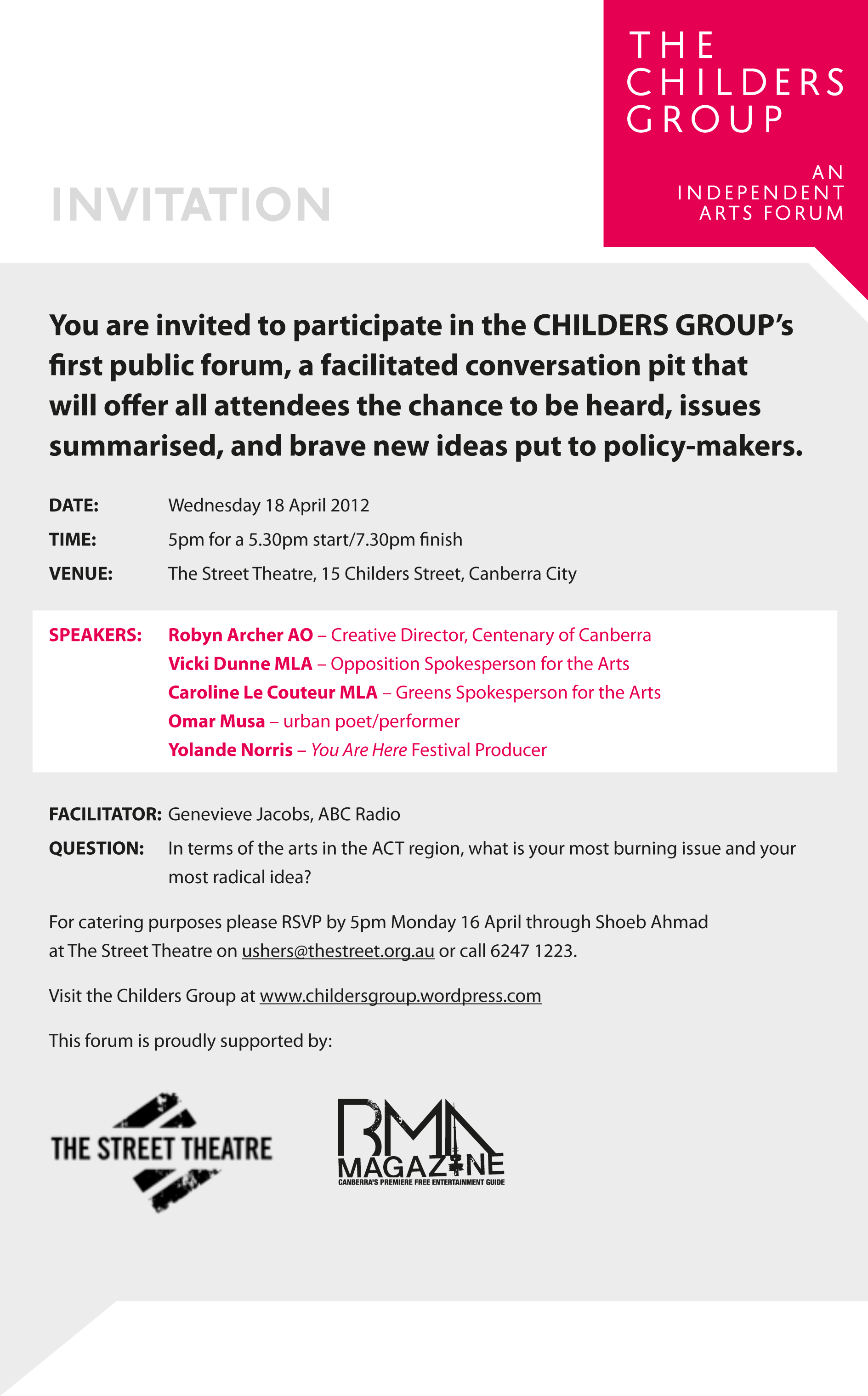
Min Mae
SUPPORT FOR THE ARTS IS AN ESSENTIAL COMPONENT OF ANY GOVERNMENT BUDGET
Introduction:
Formed in November 2011, the Childers Group welcomes the opportunity for community input into the 2012-2013 ACT Budget development process.
Comprising a group of ACT and region experienced arts leaders, the Childers Group is a new voice for the arts. It is an independent forum committed to the long-term viability and vitality of the arts in the ACT and surrounding areas. It involves recognised individuals from diverse backgrounds including the visual arts, music, dance, film, theatre and performing arts, youth arts, community arts and literature.
The Childers Group interests and activities are based on the principles of:
- objectivity;
- independence; and
- pride in Australia’s national capital city, Canberra.
General:
- The Childers Group acknowledges that since self-government the ACT Government has been the main financial supporter of the arts in the Territory.
- The ACT Government’s Arts Fund is the major ongoing support mechanism for the arts in this region.
- The Arts Fund supports 22 Key Arts Organisations that form the backbone for the employment of arts workers and much of the arts activity in the ACT and region.
- Key Arts Organisations are the basis for the development of professional arts practice and the presentation, production, performance and exhibition of this work.
- Key Arts Organisations provide the main ways ACT and residents in the region access the arts. This involves attendance at exhibitions and performances and participation in a variety of classes and workshops. It also includes programs for people with special needs such as youth at risk, the indigenous, multicultural groups and people with disability.
- The Arts Fund is also under pressure as a result of the increased number of arts facilities, and costs associated with the overall sound management and operational overheads increase each year.
- The level of funding available through the Arts Fund must be sustained and allowed to grow, at the very least to match CPI.

Elizabeth Cameron Dalman
Advocating the arts in Canberra:
- The Childers Group advocates the importance of access and participation in the arts and the value of the arts and cultural life in our community.
- The arts are a major part of the way we see ourselves and contribute to our sense of place and self esteem.
- The arts inject colour into our lives and contribute positively to many facets of community life.
- The arts and design influence the way we think about the natural and built environment, how we regard the household articles we use, and what determines the traditions we preserve.
- The arts foster cohesion and the expression of a community identity.
Why arts services important in Canberra:
- Participation in the arts fosters a sense of community, promotes mental health and well being and reduces pressures of a competitive, materialistic society (Mackay: Advance Australia Where?)
- Canberra’s creative artists and Key Arts Organisations are central to the vibrancy and life of our city.
- Galleries and museums, libraries, theatres and performance spaces, artists’ studios, workshops and cinema facilities provide essential services for the ACT and exist as the ‘common good’ for the whole community.
The presence of these facilities, services, events and activities is a measure of Canberra’s life-style, confidence and sophistication.

Boho Interactive
Arts Funding Priorities for the ACT Budget recommended by the Childers Group:
- CPI – ensure that through the ACT Arts Fund CPI continues to be provided to Key Arts Organisations on an annual basis.
- Arts Worker Salaries – ensure that there are no professional arts workers employed by Key Arts Organisations earning less than the average Australian wage approximately $55,000 pa. The Childers Group advocates benchmarking professional arts worker salaries with salaries in the Community Sector and in arts personnel in other States and Territories. Payment of ACT arts workers’ salaries commensurate with their skills and experience will ensure the retention of qualified people with the expertise to manage Canberra’s arts and cultural services.
- Increase allocation to the ACT Arts Fund’s Project Funding category – these funds support one-off activities for individual artists and groups of artists to initiate and develop their own independent projects. This acknowledges that while Key Arts Organisations provide core infrastructure, they cannot be “all things to all people”, nor do they receive program funding to engage artists on major projects. The Project Funding category is supporting fewer projects each year due to the ever increasing costs of delivering arts projects. The Childers Group advocates for this category to receive additional funding of $250,000 per annum over the next three years.
- Arts in Education – create an Arts-in-Education Officer position to build relationships, partnerships and programs between the Education Directorate and the Community Services Directorate. Ideally this should be a Senior Officer Grade C, paid for by the Education Directorate, with the officer spending 50% of time in Education and 50% at artsACT. In the first instance, this should be a three-year initiative. Similar initiatives in other States e.g. WA, have proved very beneficial. Establishing and consolidating existing inks between artists, arts organisations and schools and the tertiary sector should be a key component of the work.
- Arts in Heritage – allocate specific funds for ACT Heritage Unit to engage professional practicing artists to creatively interpret ACT Heritage sites. The outcomes will be greater community engagement, appreciation and use of heritage assets and mean professional artists are employed in sectors outside the arts.
- Following on from 6 above, adopt a Whole-of-Government approach encouraging all directorates and agencies to examine ways in which they may directly or indirectly support the arts and cultural life in Canberra. Potential also exists for the development of collaborative arts arrangements with Health and Sport.
- Artists-in-Residence – develop the success of existing artsACT residency funding and provide a program for a Key Arts Organisation Artist–in-Residence Support Fund. This would encourage arts organisations to devise their own residency projects by developing collaborative arrangements with other Government agencies, the private sector, the Australia Council or tertiary institutions.
- ACT Arts Partnership Fund –create a fund where the ACT Government dollars are matched by the private sector to assist arts partnerships. Available to both individual artists and arts organisations, this initiative could commence with $300,000 per year over three years to be matched dollar-for-dollar by the private sector. A good example exists in Tasmania with assistance from ABaF. For more information see http://www.arts.tas.gov.au/funding/grants/premiers
- Public Art – reintroduce a percentage of capital infrastructure allocation to establish a Public Art Fund available for public art commissions and acquisition of art works.
- Publicity and promotion – the arts in Canberra are an important tourist attraction. To increase publicity for the arts, ensure much closer liaison between Canberra’s arts sector and the ACT Tourism and the national capital cultural institutions.
- Research – increase the research capacity of artsACT by establishing a Senior Officer Grade C position as a three-year initiative. Work in this position would enable increased capacity to undertake much needed research to support ACT arts policy development, communicate and explain the basis of research findings and rationale for the arts and cultural development initiatives proposed.
The ACT leads our nation in both community participation and attendance at arts and cultural events. The Childers Group recommends consideration of increased investment in the arts as outlined in our submission.
With this kind of support, Canberra will continue its development as a vibrant, engaged, confident and sophisticated National Capital and adjacent region.
The next creative generation depends on it.

QL2 Centre for Youth Dance
 The recently released draft ACT Arts Policy Framework supersedes Arts Canberra: Action Statement for the Arts 2006-2008 and, we assume, related documents such as the ACT Action Statement for Public Art (May 2007).
The recently released draft ACT Arts Policy Framework supersedes Arts Canberra: Action Statement for the Arts 2006-2008 and, we assume, related documents such as the ACT Action Statement for Public Art (May 2007).






